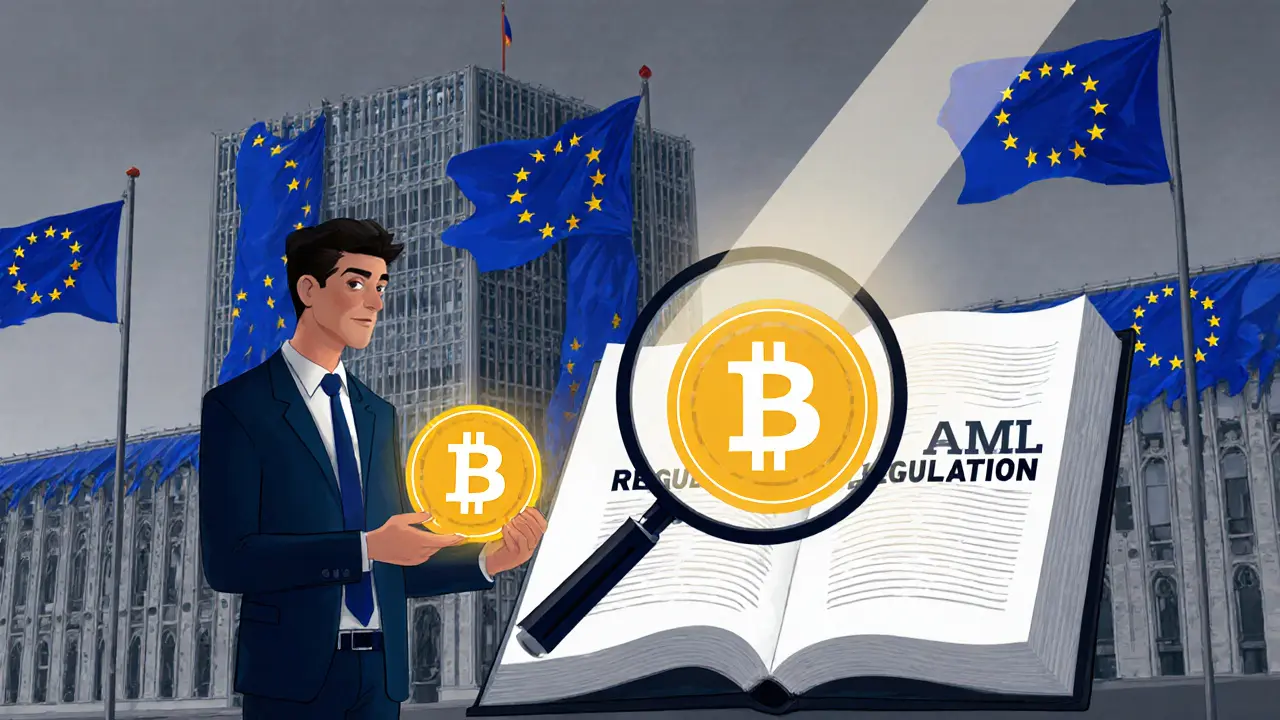EU Crypto AML Compliance Cost Calculator
Calculate your estimated annual EU AML compliance costs based on your business type, staff size, and regulatory requirements. Based on 2025 industry data.
Estimated Annual Compliance Costs
When the European Union tightened its anti‑money‑laundering rules for digital assets, crypto firms suddenly faced a whole new compliance playbook. EU AML Regulation is a set of EU‑wide obligations that force crypto‑businesses to treat every transaction like a bank‑transfer, run thorough customer checks, and report suspicious activity to national FIUs. In practice, the rulebook stitches together the Fifth and Sixth AML Directives (AMLD5, AMLD6), the Markets in Crypto‑Assets Regulation (MiCA), and the brand‑new Anti‑Money‑Laundering Authority (AMLA) framework that kicks in July 2027. This guide walks you through what you need to know, where the toughest hurdles lie, and how to stay ahead of the next wave of EU scrutiny.
Why the EU moved from AMLD5 to a single AML Regulation
AMLD5, which became effective in January 2020, was the EU’s first attempt to bring crypto exchanges and custodial wallets under the same lens as traditional banks. It required registration, customer‑due‑diligence (CDD), and suspicious‑transaction reporting. Six years later, regulators realized the patchwork still left loopholes - especially for cross‑border services and decentralized finance (DeFi). AMLD6 added a harmonised list of predicate offences, stronger penalties for senior managers, and clearer cross‑border cooperation. The next logical step was a single AML Regulation (AMLR) that replaces the layered directives, gives AMLA a pan‑EU supervisory mandate, and closes gaps that criminals were still exploiting.
Core obligations for Crypto‑Asset Service Providers (CASPs)
Under the combined AML framework, every CASP - whether you run a fiat‑to‑crypto exchange, a custodial wallet, or a token‑trading platform - must meet the same baseline duties:
- Risk‑based KYC: tiered verification based on transaction size (under €1,000, €1,000‑€10,000, over €10,000) as spelled out in AMLA’s 2025 Work Programme.
- Designate a Money Laundering Reporting Officer (MLRO) who owns the reporting pipeline.
- Maintain an internal AML policy, staff‑training programme (40 hours per year for compliance staff, 16 hours for ops staff), and periodic self‑assessments.
- Integrate the Travel Rule - six data elements per transfer - with all 28 national FIU interfaces.
- Conduct enhanced due diligence for high‑risk customers, source‑of‑funds checks, and senior‑management sign‑off for transactions above €10,000.
Missing any of these steps can trigger fines up to €10 million or 10 % of annual turnover, a penalty structure introduced by AMLD6.
MiCA licensing and its interaction with AML rules
MiCA, fully effective in 2024, gave crypto firms a EU‑wide licence - the Crypto‑Asset Service Provider (CASP) licence - that replaces 27 national authorisations. To keep that licence, you must embed the full AML stack inside your MiCA compliance programme. The European Securities and Markets Authority (ESMA) reports that licence applications now take 9‑12 months and cost €350‑€500 k for set‑up, largely because regulators demand a complete AML architecture before they sign the permit.
Travel Rule in practice - a real‑world checklist
Europe’s Travel Rule differs from the US approach by applying to every crypto transfer, no matter how small. Here’s the data you must collect for each transaction:
- Originator name
- Originator account number (crypto address)
- Originator physical address or date of birth
- Beneficiary name
- Beneficiary account number (crypto address)
- Beneficiary physical address
For transfers above €1,000, you also need a screenshot of the source‑of‑funds document. The biggest headache is wiring this data to 28 different national FIUs. Most large players now use middleware such as the Traveler platform - a one‑off €420 k setup that shrinks integration time to eight weeks.
Common compliance pitfalls and how to avoid them
Even seasoned firms stumble over a few recurring issues:
- Forum shopping: Setting up a shell company in a low‑scrutiny jurisdiction only to process EU traffic. AMLA now screens beneficial‑ownership structures across borders, so keep your corporate chain transparent.
- DeFi gray area: Decentralised protocols lack a central operator, making the CASP definition fuzzy. The EBA advises treating every on‑ramp/off‑ramp as a “controlled service” and applying the same KYC checks.
- Self‑hosted wallet verification: The Transfer of Funds Regulation forces you to identify owners of non‑custodial wallets for transfers over €1,000. Deploy a wallet‑linking solution that captures identity documents before the hand‑off.
Address these early, and you’ll sidestep the costly enforcement actions that hit firms like the Estonian‑registered CASP mentioned in the 2025 EBA report.
Cost snapshot - what you’ll actually spend
Compliance isn’t cheap, especially for startups. Here’s a rough breakdown based on 2025 industry surveys:
| Cost Category | Range (EUR) | Notes |
|---|---|---|
| MiCA licence application | 350,000‑500,000 | Legal fees, audit, system upgrades |
| Travel Rule integration (per FIU) | 185,000 | Average cost for API connections; middleware can reduce total spend |
| Annual AML staff salaries (3‑5 FTE) | 240,000‑400,000 | Includes training and certification |
| Technology (monitoring, reporting, KYC) | 120,000‑250,000 | Transaction‑monitoring platforms, risk‑scoring engines |
Smaller firms often cite these figures as prohibitive - the European Commission’s 2025 SME Impact Assessment found 68 % of crypto startups with fewer than ten employees label the costs as a barrier to EU entry.

Future outlook - the 2027 AML Regulation and beyond
July 1 2027 will see the EU‑wide AML Regulation replace AMLD5/6 completely. Key new rules include:
- Five‑day deadline for FIU response to information requests.
- EU‑wide cash‑payment cap of €10,000 for business transactions; mandatory verification for cash above €3,000.
- Extension of obliged entities to include crowdfunding platforms, professional football clubs, and high‑value‑goods traders.
- Guidance on privacy‑enhancing technologies slated for Q1 2026, focusing on zero‑knowledge proofs and mixers.
Analysts predict another 40‑55 % drop in illicit crypto flows once the 2027 rule hits, building on the 63 % reduction already seen after MiCA. However, the tighter environment may push a slice of innovative startups toward crypto‑friendly hubs like Singapore or Switzerland.
Quick checklist to stay compliant today
- Confirm your AMLD5‑derived registration with the national authority.
- Secure a MiCA CASP licence if you haven’t already - budget 9‑12 months and €350‑500 k.
- Appoint an MLRO and set up a documented AML policy.
- Implement tiered KYC and ensure data capture for all six Travel Rule fields.
- Integrate with the 28 national FIU APIs - consider a middleware provider.
- Run quarterly AML staff training (40 h compliance, 16 h ops).
- Perform a yearly gap analysis against AMLA’s 2025 Work Programme.
- Prepare for the 2027 AML Regulation by documenting cash‑payment processes now.
Follow these steps, and you’ll be in a solid position to avoid fines, keep your MiCA licence, and focus on growth rather than regulatory firefighting.
Frequently Asked Questions
Do I need a MiCA licence to comply with EU AML rules?
Yes. The MiCA licence is the legal gateway for any crypto‑asset service provider operating in the EU. Without it, you cannot lawfully carry out the AML‑related activities that regulators demand.
What is the threshold for the Travel Rule in the EU?
The EU applies the Travel Rule to every crypto transfer, but enhanced verification is triggered for amounts over €1,000. Full data capture is mandatory for all transfers.
How many staff members are typically required for AML compliance?
During the MiCA application phase, firms usually allocate 3‑5 full‑time compliance professionals. Ongoing operations need at least one dedicated MLRO plus a support team for monitoring.
Can DeFi protocols be subject to EU AML rules?
The EBA advises treating any on‑ramp or off‑ramp that links fiat to DeFi as a "controlled service". Those interfaces must follow the same KYC and reporting obligations as traditional CASPs.
When does the new EU AML Regulation take effect?
The regulation becomes binding on 1 July 2027, although many provisions (like the five‑day FIU response deadline) will be phased in through 2026.
- Poplular Tags
- EU crypto AML requirements
- crypto AML regulations
- MiCA compliance
- AMLD5
- AMLA













People Comments
The EU’s new AML framework certainly raises the bar for crypto firms, and it’s understandable that many are feeling the pressure. It aims to close loopholes that have been exploited in the past, and the inclusion of the Travel Rule across all transfers shows a commitment to transparency. While compliance costs can be daunting, a structured approach-starting with risk‑based KYC and appointing a dedicated MLRO-can make the transition smoother. Companies that invest early in robust AML infrastructure are likely to avoid the steep fines outlined in the regulation. Ultimately, the goal is to protect both consumers and the broader financial system, which benefits the industry as a whole.